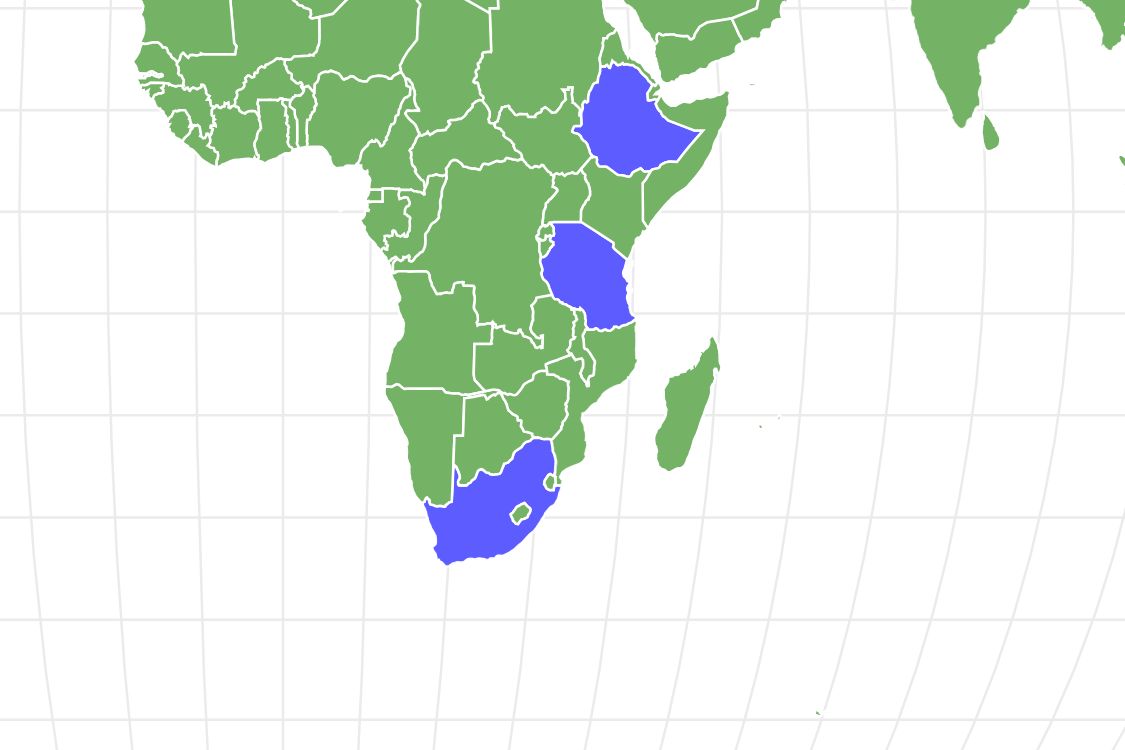Australopithecus
Advertisement
Australopithecus Scientific Classification
- Kingdom
- Animalia
Read our Complete Guide to Classification of Animals.
Australopithecus Conservation Status
Australopithecus Facts
- Diet
- Omnivore
Australopithecus Physical Characteristics
View all of the Australopithecus images!
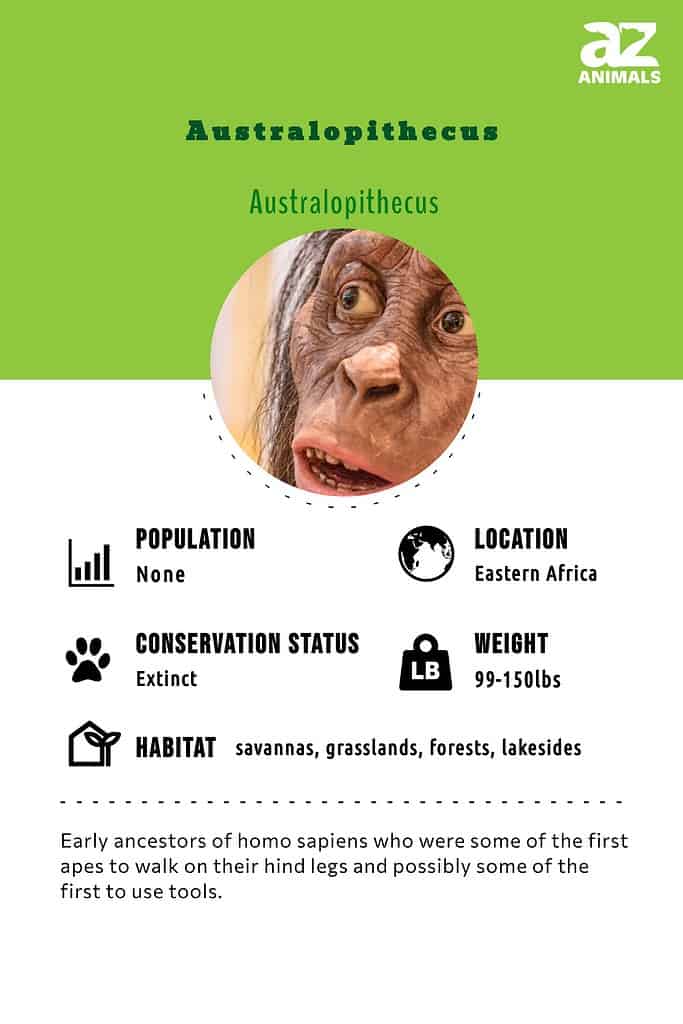
Evolution
Australopithecus was a genus of ancient primates, believed to be a close relative of modern humans and human-like ancestors. There are approximately ten recognized species of Australopithecus that lived around 4.4 million to 1.4 million years ago. Ever since the first fossil was discovered, paleontologists have debated whether Australopithecus represents a direct ancestor of humanity or a side branch. The earliest members of the Australopithecus genus were certainly more ape-like than humans. Various later species of Australopithecus have been proposed as possible direct ancestors of the Homo genus to which we belong, but the matter has not been properly resolved.
Australopithecus nevertheless reveals some important facts about human evolution. It has definitively proven to be a bipedal animal, meaning it had the ability to walk upright on two legs. This bipedalism probably evolved early on after it split off from other apes some 6 to 7 million years ago. And yet in many other respects, Australopithecus shares more in common with modern apes, which suggests that the characteristics unique to humans only evolved later on within our own genus of Homo. Our theories about human evolution continue to develop as more evidence is uncovered.
Description & Size
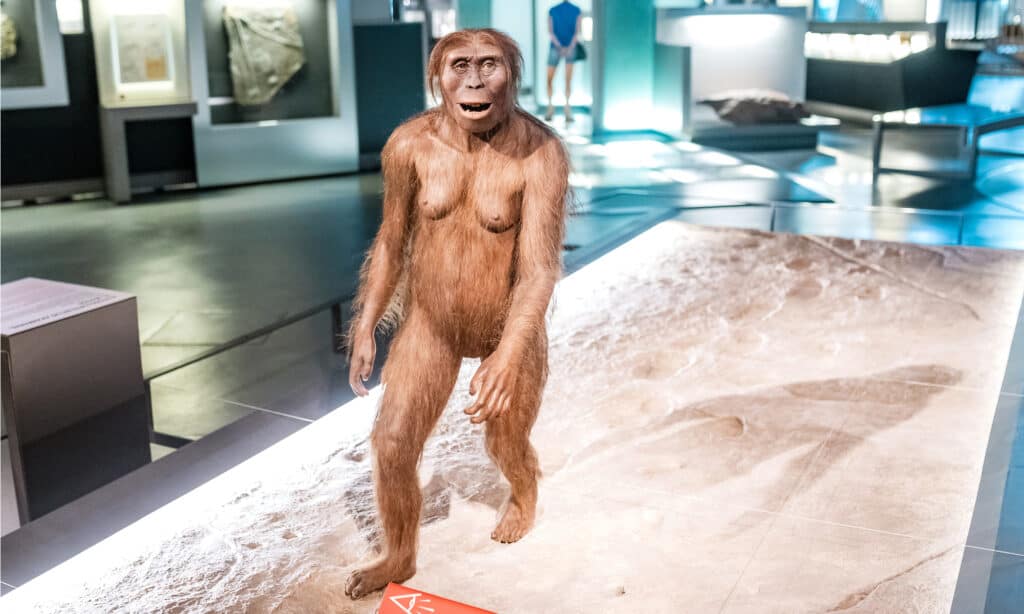
The Australopithecus were bipedal, meaning they walked upright like humans.
©frantic00/Shutterstock.com
Depending on the species, Australopithecus featured an interesting cross of human-like and ape-like characteristics. Altogether, it probably had more ape-like features, including a flat nose, a strong jaw that projected outward, long arms, curved fingers, and a small braincase; the brain was thought to be about a third the size of a modern human. It also probably had thick hair covering most of its body. However, Australopithecus also began to evolve some human-like features, including small canine teeth and the ability to walk upright on two legs. All the members of this genus probably split their time between living on the ground and living in the trees. Even as they walked upright, their arms and hands were well-adapted for climbing.
Australopithecus tended to be shorter than modern humans and showed a strong degree of sexual differences in height. Based on what we know of the fossils of Australopithecus afarensis, for example, the male stood about an average of 5 feet tall and weighed 92 pounds, whereas the female stood about 3 feet 5 inches tall and weighed around 64 pounds on average. Australopithecus africanus, on the other hand, tended to have shorter males and taller females, so the difference was only an average of 7 inches between them. Unlike many other primate species, in which the size of the male canine teeth is a mark of dominance, the canines of the males and females of the Australopithecus genus are about the same size. This may have something to do with differences in social structure and behavior compared with other great apes.
The name Australopithecus derives from the combination of two words: australis means southern in Latin, whereas pithekos means ape in Greek. Together this term means southern ape. The name refers to the fact that the first fossils were found in South Africa. In reality, it lived no more south than other apes.
Here is a quick breakdown of the characteristics of Australopithecus:
- Ape-like face with a flat nose and strong protruding jaw
- Small canine teeth
- Long arms with curved fingers
- Small braincase
- Long bipedal legs for walking upright
- Body covered in dense hair
Behavior and Society
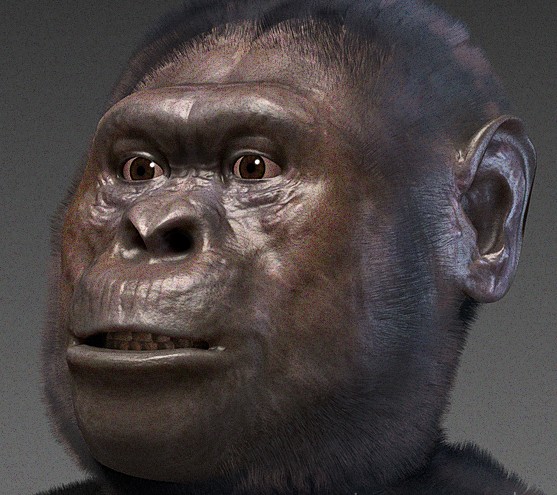
Australopithecus was believed to have a brain one-third the size of humans.
©By Cicero Moraes – Own work, CC BY-SA 4.0, https://commons.wikimedia.org/w/index.php?curid=23804678
The cognitive ability of Australopithecus is one of the most debated aspects of its physiology. For a long time, it was assumed that Australopithecus did not have the ability to produce complex stone tools, but more recent archaeological findings from 1994 and later from 2010 indicate that some members of Australopithecus were hunting for meat and even using stone tools to do it as early as 3.4 million years ago. Their hand anatomy appears well-suited for gripping and manipulating tools.
Studies of its skeleton have shown that Australopithecus probably did have the ability to hang from branches and support its entire weight with its arms. It’s also been suggested that some species may have slept in trees during the night. It’s not entirely clear why bipedal locomotion emerged in human-like ancestors, but Australopithecus proves that bipedalism predates the evolution of larger brains, whereas for a long time was assumed to be the other way around.
Australopithecus likely lived in fairly complex societies, but the exact nature of these societies remains unknown. The smaller canine teeth of the males could indicate less overall aggression and competition for mates compared with other great apes.
Diet – What Did Australopithecus Eat?
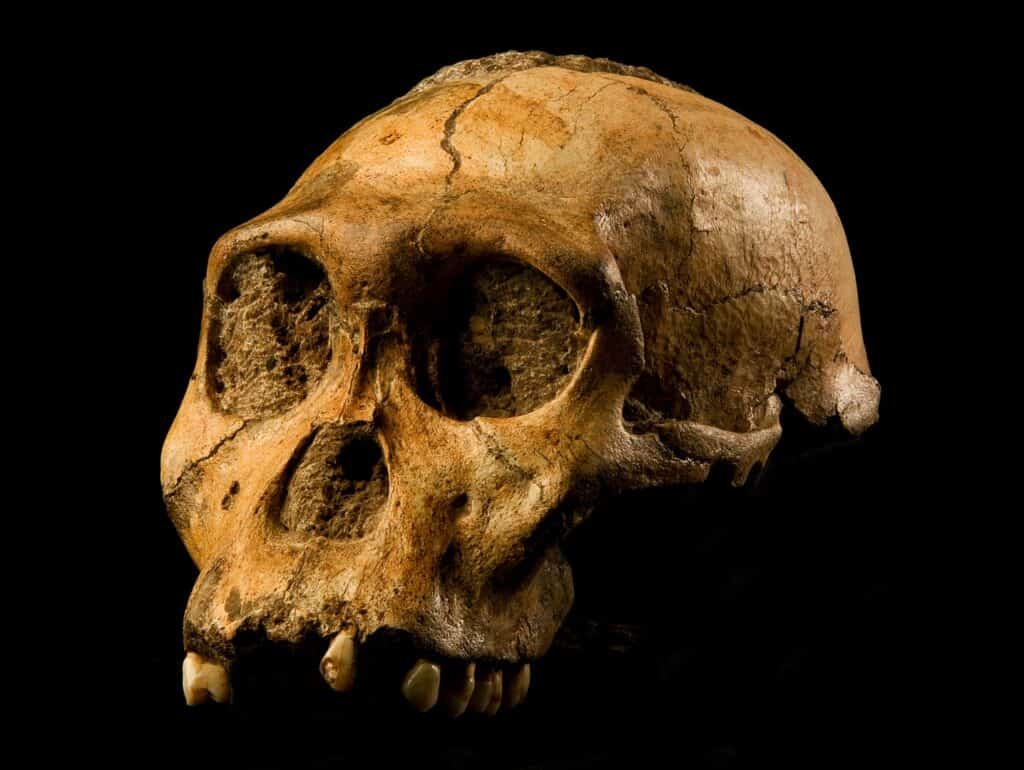
The examination of Australopithecus teeth has been scientists’ primary means of reconstructing this ancient ape’s diet.
©By Photo by Brett Eloff. Courtesy Profberger and Wits University who release it under the terms below. – Own work, CC BY-SA 4.0, https://commons.wikimedia.org/w/index.php?curid=10094681 – License
Australopithecus was thought to eat mostly a plant-based or invertebrate-heavy diet, including fruits, vegetables, seeds, roots, nuts, and even insects. They may have also occasionally consumed small vertebrates such as lizards to supplement their diet. Scientists can determine their diet by examining the fairly mild wear and scratches on their teeth. The size and shape of their teeth also indicate they were capable of eating harder foods as well, but overall, meat probably formed an overall small part of their diet.
Habitat – When and Where It lived
Australopithecus probably lived some 4.4 million to 1.4 million years ago during the Pliocene and Pleistocene epochs. Members of this genus preferred to live in the grasslands, savannas, and open woodlands throughout Eastern and Southern Africa, often with plenty of tree cover around. The greatest concentration of fossils has been found around Ethiopia and the Horn of Africa region. Different species of Australopithecus and other human-like genera all lived together and overlapped to some degree.
Threats and Predators
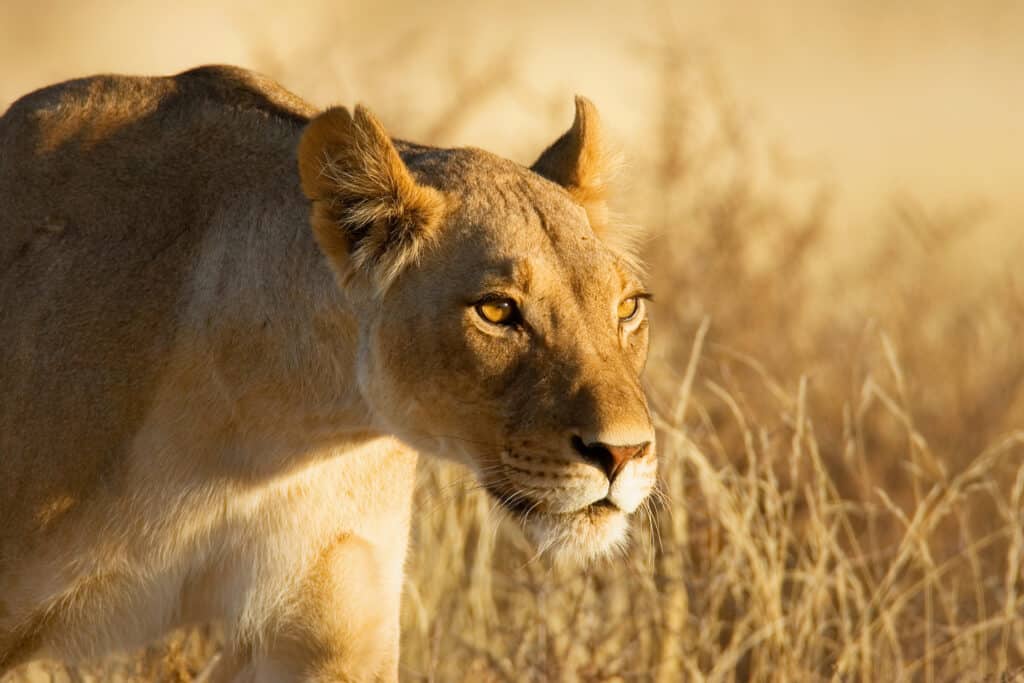
Lions could have been one of Australopithecus’ most vicious predators.
©Johan Swanepoel/Shutterstock.com
Depending on the age and size of the individual, Australopithecus was probably preyed upon by wild dogs, hyenas, crocodiles, eagles, and big cats like lions. One estimate put the rate of predation at somewhere between 6 and 10 percent. This is comparable to the rate of predation for antelopes and ground-living monkeys as well.
Discoveries and Fossils – Where It was Found
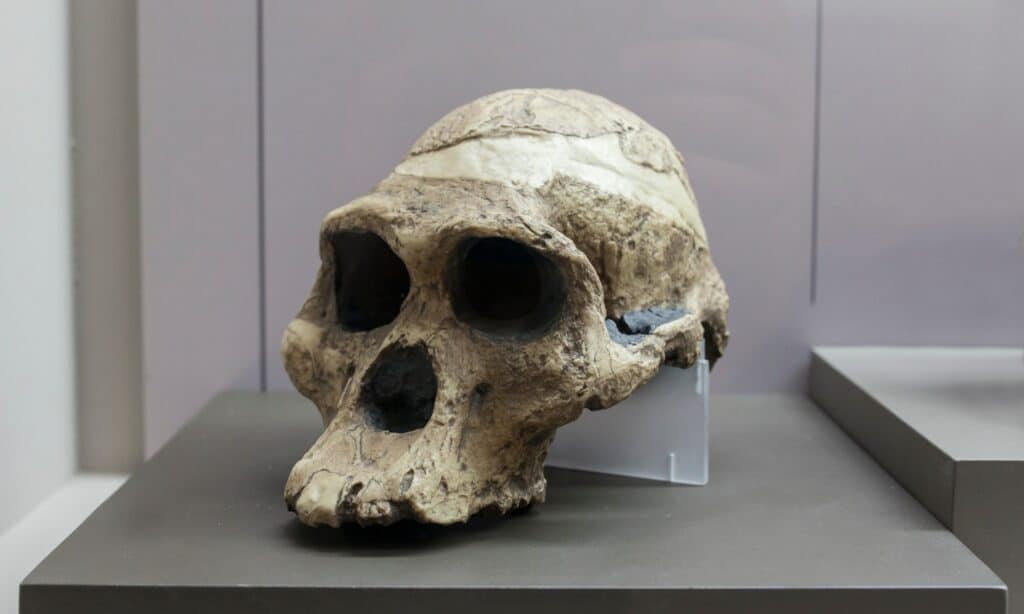
This Australopithecus skull replica illustrates the trademark protruding jaw structure.
©WH_Pics/Shutterstock.com
Australopithecus fossils were found as early as 1924 in a lime quarry in South Africa. The first fossil was named the Taung Child after the town in which it was found. This skull was soon identified as belonging to an entirely new species called Australopithecus africanus. However, it took a few more decades before scientists reached a consensus about its place in the evolutionary tree. At that time, it was still being debated whether the Taung Child was an example of early human-like ancestors or mere non-bipedal apes. Because they uncovered nothing more than a skull, scientists could say nothing about how it moved around.
Perhaps the most well-known specimen ever found was Lucy, a member of the species Australopithecus afarensis who lived some 3.2 million years ago. Named after the famous Beatles song “Lucy in the Sky with Diamonds,” some 40 percent of her skeleton was found in 1974 at the Awash Valley excavation site in Ethiopia. By meticulously reconstructing her skeleton, scientists could demonstrate reasonably that Lucy had a pelvis and leg bones that resembled modern humans. It was considered to be one of the most important and infamous findings in paleontological history.
Since then, even more complete skeletons have been found. Between 1994 and 1998, an Australopithecus specimen named Little Foot was found in the cave system of Sterkfontein, South Africa. Although it was difficult to recover from the rock, the skeleton was almost entirely complete and yielded important clues about its anatomy. Dating showed that it was alive around 3 million years ago. The earliest example of bipedalism in primates dates back some 3.6 million years ago. Footprints were found in volcanic ash near the Laetoli excavation site in Tanzania. They are most commonly attributed to Australopithecus afarensis and possibly another species.
Extinction – When Did It Die Out?
Australopithecus as a genus is thought to have died out around 1.4 million years ago. It is not entirely clear why Australopithecus eventually went extinct. Various explanations have been proposed, including the possibility of a changing climate and fierce competition with the early members of the Homo genus. The earliest members of our genus such as Homo habilis probably emerged more than 2 million years ago, which means it overlapped with Australopithecus for a short time.
Similar Animals to the Australopithecus
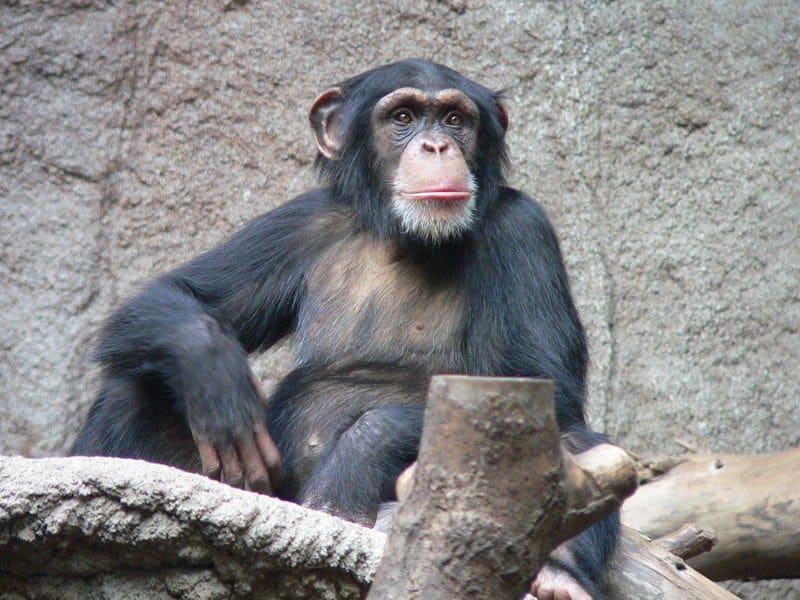
Chimpanzees are Australopithecus’ closest living relatives.
Australopithecus is probably most similar to the apes from which it evolved, as well as other human-like species. These include:
- Paranthropus – This genus lived at about the same time as the Australopithecus. In fact, the two are so similar that some experts place them both within the same genus. Just like Australopithecus, it was mostly ape-like in nature, but it was also bipedal and capable of using more complex stone tools.
- Homo habilis – This species has long been thought to be an early example of human ancestors. However, because of its smaller brain and more ape-like features, some experts have argued that it should be a member of the Australopithecus genus, not Homo.
- Chimpanzees – The closest living relative of Australopithecus is probably the chimpanzee. Apart from the upright stature of Australopithecus, they had fairly similar anatomy and diet.
Types of Australopithecus
| Australopithecus anemensis | The most ancient member of the Australopithecus family, this ape lived sometime 4.2 million to 3.9 million years ago. |
| Australopithecus deyiremeda | Only discovered in 2015, this Australopithecus lived 3.3-3.5 million years ago. |
| Australopithecus bahrelghazali | 3.5 million to 3 million year old species discovered in the 1990’s in Chad. |
| Australopithecus aethiopicus | The largest known members of their family, aethiopicus lived 2.7 million to 2.3 million years ago. |
| Australopithecus garhi | Perhaps the first austalopithecus to use stone tools, only one complete skull fossil and a few small fragments of this 2.5 million year old ape have been discovered. |
| Australopithecus robustus | 1.9 million to 1.2 million year old Australopithecus first discovered in 1938. |
| Australopithecus boisei | Lived 2.3 million to 1.4 million years ago, this ape is another contender for the first maker of primitive tools. |
| Australopithecus sediba | 2 fossils of this species dated to be 1.78 million and 1.95 million years old were discovered in 2008. |
| Australopithecus africanus | Lived in Southern Africa about 3.3 A to 2.1 million years ago. The “Tuang Child” specimen belongs to this species. |
| Australopithecus afarensis | Lived about 3.9 million to 2.9 million years ago, the famous fossil “Lucy” is a member of this species. |
Australopithecus FAQs (Frequently Asked Questions)
How do you pronounce the name Australopithecus?
The first half of the name is pronounced as aw-stray-low. The second half of the name is pronounced like the pith in pithy, followed by a short eh sound, and finally cus as in cuss.
When was Australopithecus alive?
Based on fossil evidence, Australopithecus as a group lived some 4.4 million to 1.4 million years ago. Of course, because our fossil evidence is incomplete, new fossils might be discovered in the future that extend its time frame a bit.
How big was Australopithecus?
Depending on the species and the sex, an adult Australopithecus normally reached at least 3 feet tall. Some of them measured more than 5 feet in height.
Did humans evolve from Australopithecus?
Human evolution is still one of the most debated topics in the field of evolution. One of the leading theories is that our human-like ancestors evolved from a branch of Australopithecus, but it’s not entirely clear which species is responsible. Both Australopithecus africanus and Australopithecus sediba have been cited as potential candidates. Africanus lived within the last 2 million years and overlapped with some species of the Homo genus for a time. What’s really needed to clarify matters is more evidence as new fossils are discovered and studied.
It’s important to note that the transition between Australopithecus and Homo did not immediately lead to massive changes. It was only a little later that we begin to see increased brain size, a reduction in jaw size, and a loss of hair within the Homo genus. That is why some experts recommend moving Homo habilis to the Australopithecus genus.
Thank you for reading! Have some feedback for us? Contact the AZ Animals editorial team.
Sources
- USC, Available here: https://news.usc.edu/184862/little-foot-fossil-analysis-human-ape-evolution-usc-research/
- National Museum of Natural History, Available here: https://humanorigins.si.edu/evidence/human-fossils/species/australopithecus-afarensis
- Britannica, Available here: https://www.britannica.com/topic/Australopithecus/Australopithecus-afarensis-and-Au-garhi
- Science Daily, Available here: https://www.sciencedaily.com/releases/2010/08/100811135039.htm
- ARS Technica, Available here: https://arstechnica.com/science/2021/12/at-least-2-hominin-species-lived-at-laetoli-site-3-6-million-years-ago/

